아빠 Father
acrylic on paper
109x72cm
2013
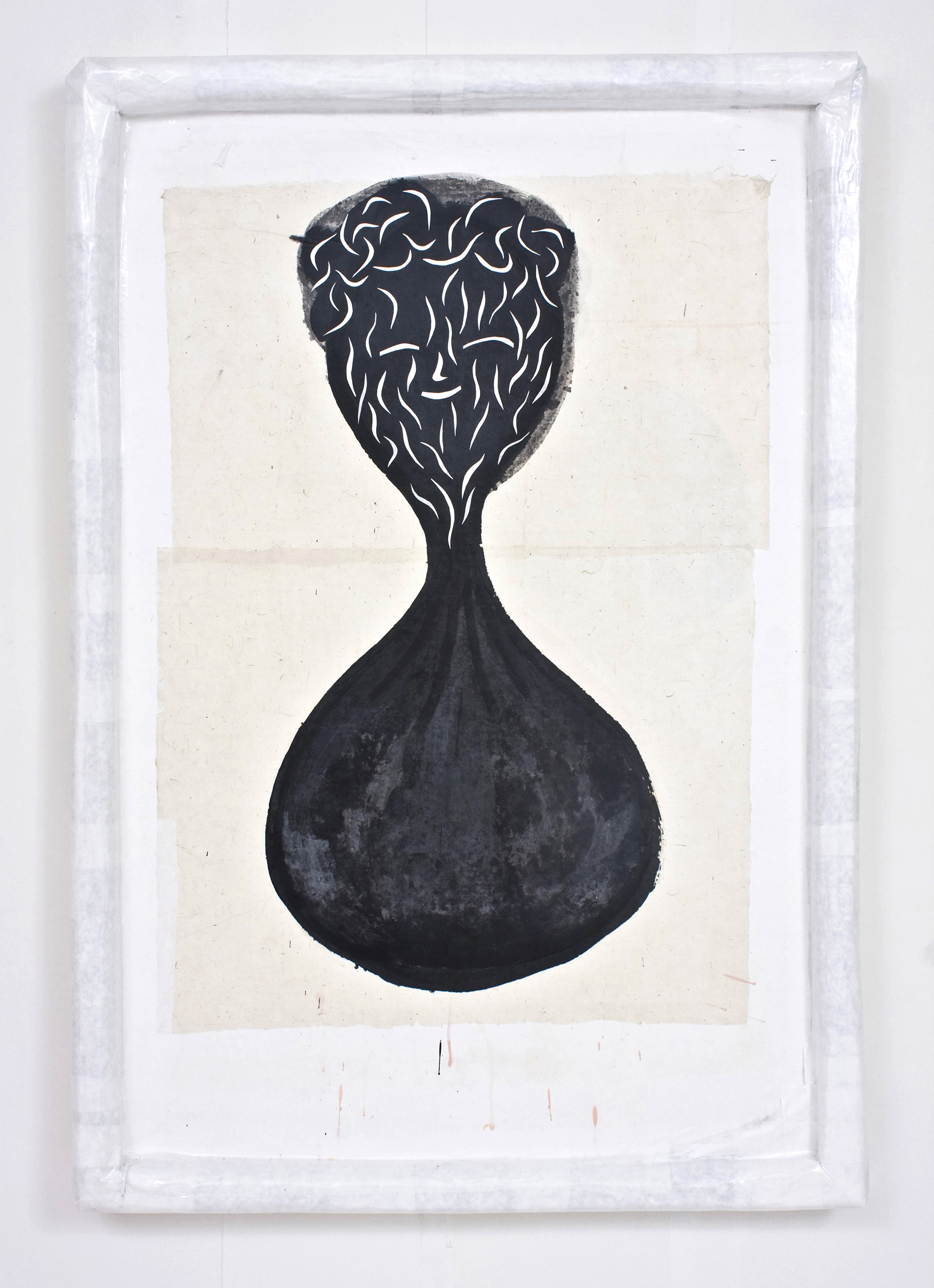
만두엄마 Dumpling Mom
ink, acrylic on paper, styrofoam
97x136cm
2011

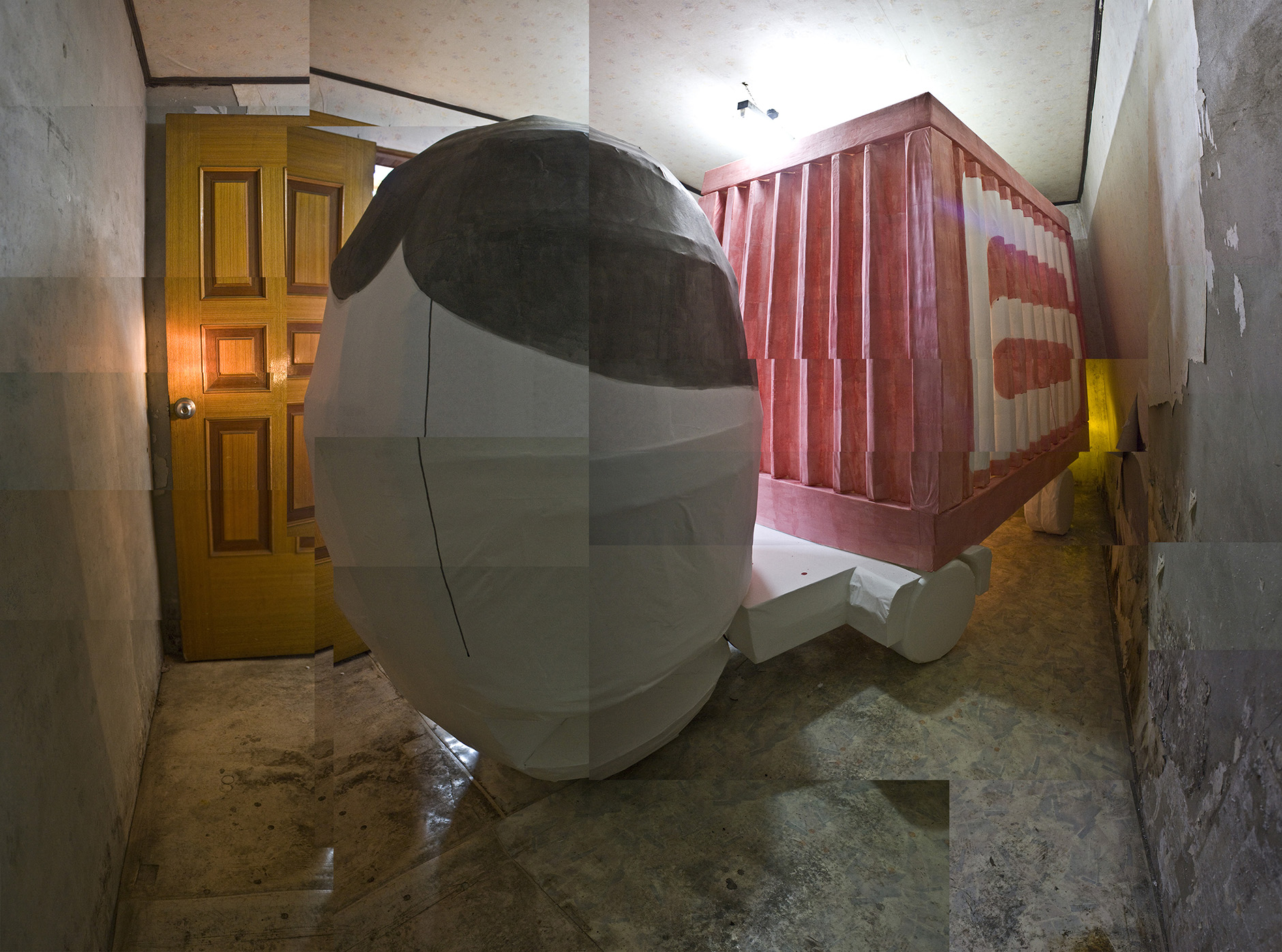

화물차가 된 아빠 The daddy who becomes a truck
ink, acrylic on paper, bulb, LED, styrofoam
340x130x210cm
2011


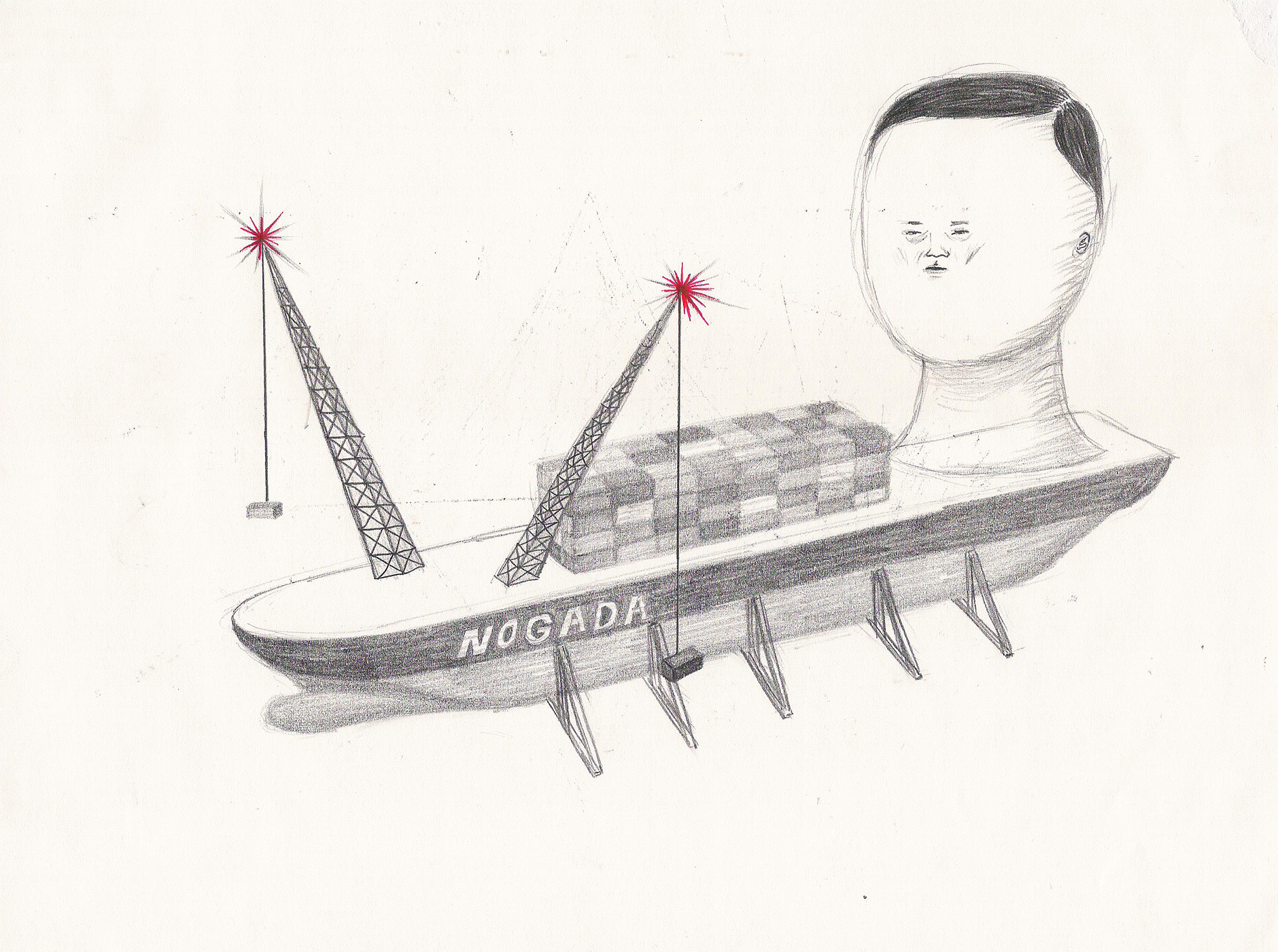
화물선이 된 삼촌 The uncle who becomes a cargo ship
ink, acrylic on paper, bulb, styrofoam
270x100x230cm
2011

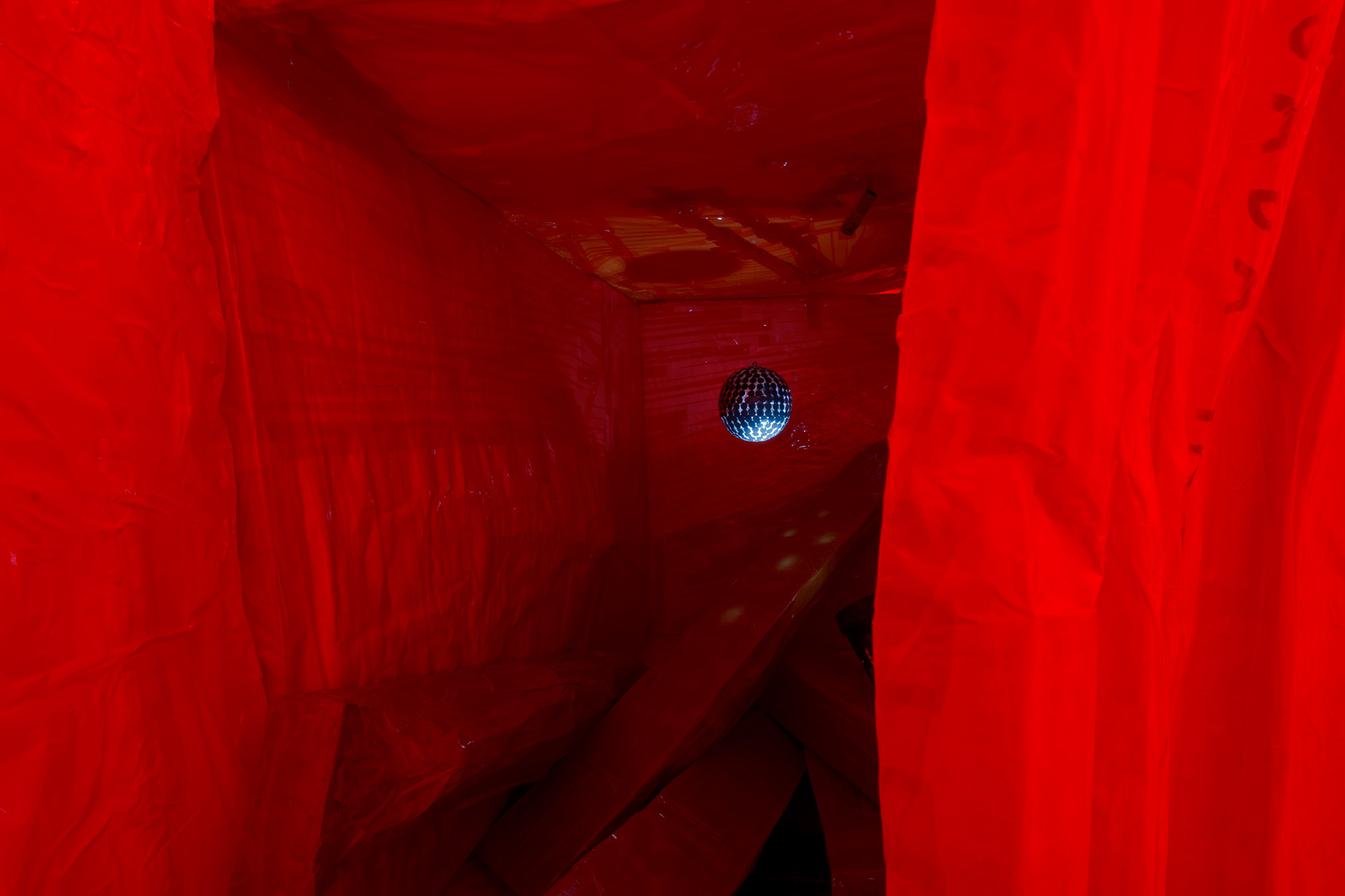
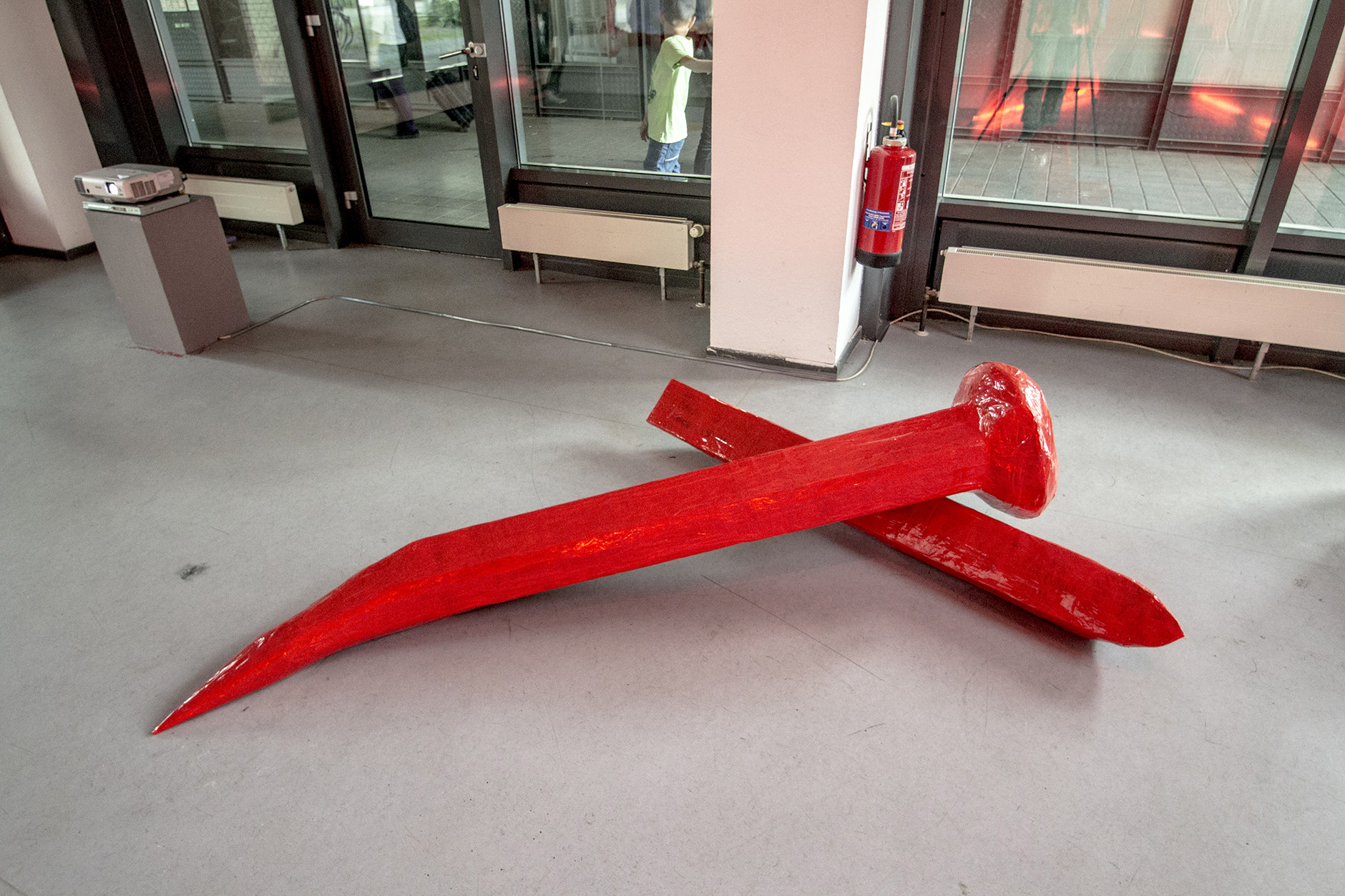
가족 Family
light, plastic tape, polystyrene, acrylic
variable dimension
2013
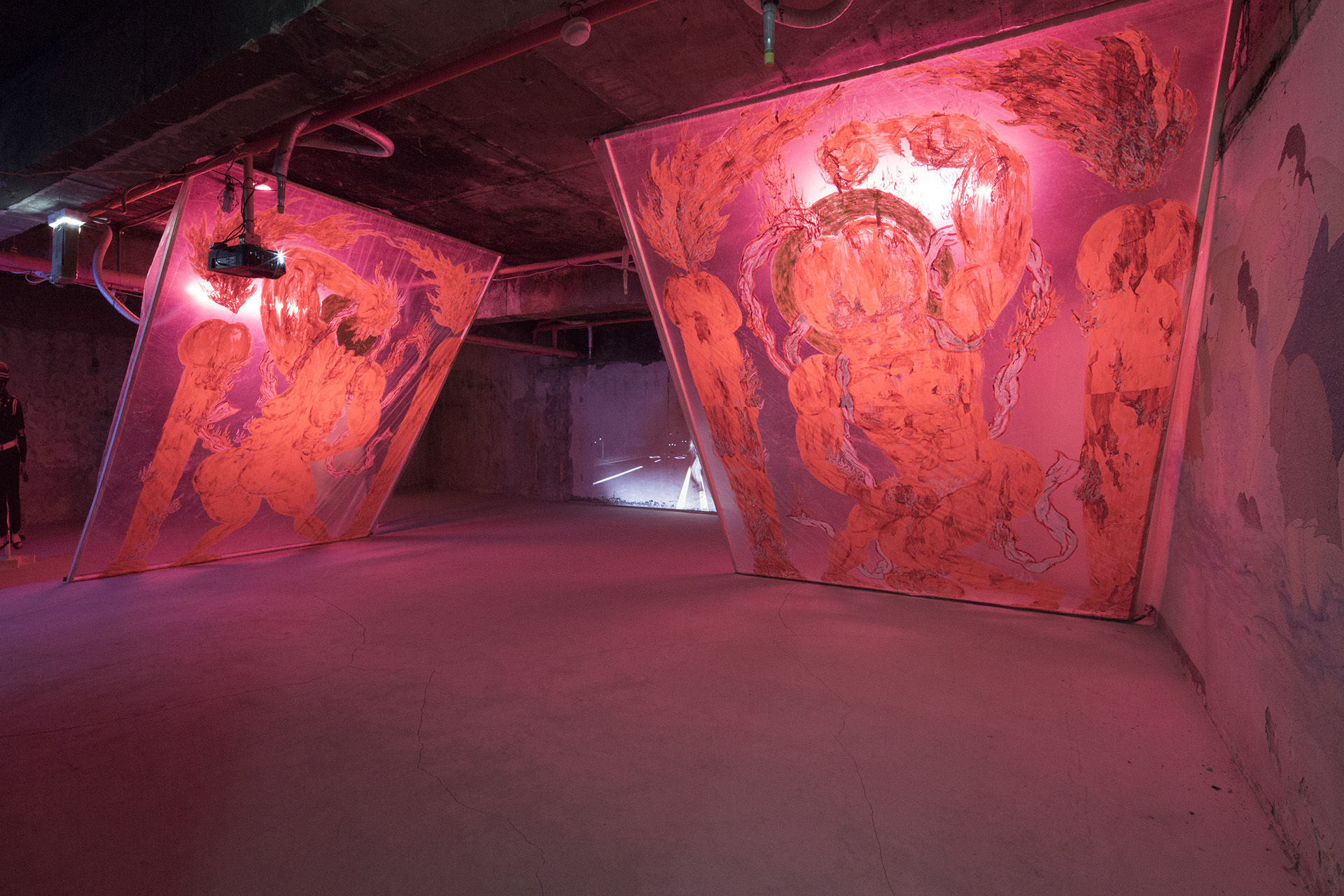
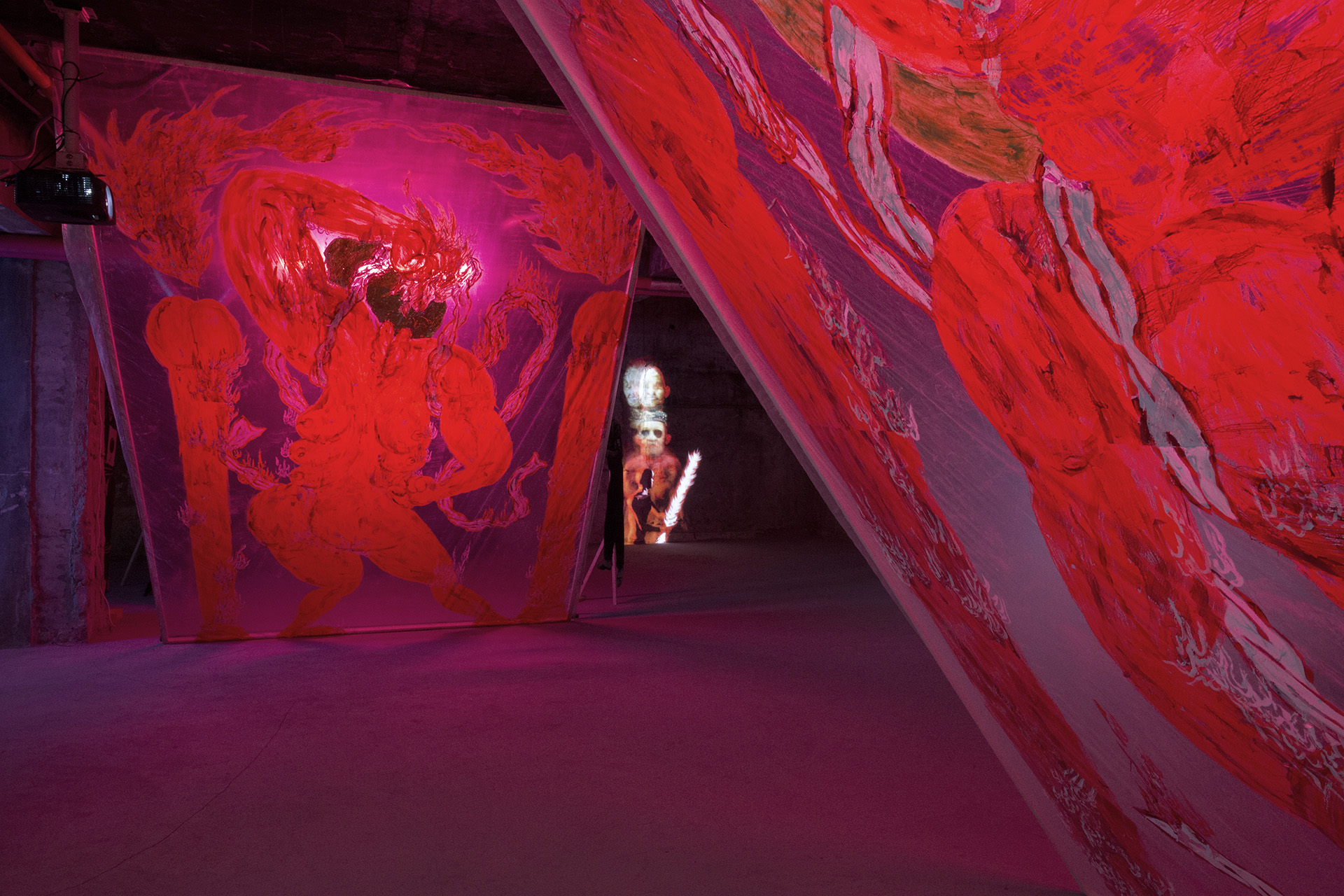
욕망의 데바 Deva of Desire
paint on waste-vinyl
300x560cm
2013

즐거운 나의 집 My Home Sweet Home
sound 4’45”, star-light(bulb), acrylic on polystyrene and waste-vinyl
245x520cm
2012
즐거운 나의 집
-오혜미(인천아트플랫폼 큐레이터)
현실은 뜨겁다.
뜨거울 거라 충분히 예상은 했지만
늘 현실은 상상보다 잔인하다.
삶에 관한 이야기는 누구나 복잡하기도 하고 의외로 단순하기도 하다. 그의 개인사를 들여다보기 위해 잠시 상상해 보자.
담장 옆 앞마당에 목련 나무가 서 있는 집에 살았다. 아버지는 시장에서 할머니 일을 돕기도 하셨고, 이발소 일을 돕기도 하시다가 외항선을 타는 사람들을 알게 되어 배 만드는 일을 시작하시게 되었다. 그때만 해도 아버지는 배 타는 것에 대한 작은 꿈이 있으셨다. 손재주가 있으셨던 아버지는 발코니라든지, 닭장이라든지 온갖 집에 필요한 물건들을 직접 만드셨는데, 배 만드는 일도 곧잘 집에서 계속하셨다. 술에 취해 오신 날, 한번은 마당 위에 널브러져 계신 적도 있었다. 그뿐만 아닌 것이 어느 날 밤 우연히 까만 비닐봉지가 꿈틀거리길래 들여다봤더니 노숙자가 마당에 들어와 자고 있던 적도 있었다. 거친 일을 하는 아버지와 삼촌, 식구들 때문에 무당이신 이모할머니는 우리 집 마당에서 가족의 안녕을 비는 푸닥거리나 비나리를 가끔 하셨다. 그러다 어느 날 우리는 아파트로 이사하게 되었고 발코니라든지, 배 만드는 아버지의 모습을 다시는 볼 수 없게 되었다.
만약 어렸을 적 모든 추억이 깃든 그 집이 그리워 그곳을 찾아갔는데 도시 재개발로 흔적도 없이 사라졌다면, 어쩌면 이런 기억조차 생각할 여유가 없는 샐러리맨이 되었는데 이러한 기억이 당신의 이야기라면...
이번 즐거운 나의 집 전에서 김수환은 어렸을 적 살았던 집을 주요 배경으로 그 당시의 기억들과 가족에 관한 이야기들을 진솔하게 풀어내고 있다. 비닐 위에 쉽게 그려진 소소한 일상에 관한 이야기들은 거대한 실타래가 되어 하나의 평면에 뒤얽혀 있다. 그리고 그 뜨거운 현실 앞으로 작가의 ‘즐거운 나의 집’ 콧노래가 전시장에 울려 퍼진다. 김수환은 “노동자들의 도시, 인천” 시리즈를 통해 개항과 근대 산업화의 요충지였던 인천에서 노동자로 살아온 가족들이 고착화된 거대권력과 사회구조 안에서 어떻게 변모하는 삶을 살아왔는지를 작업에 투영해 왔다. 그리고 이러한 개인사를 토대로 노동과 도구에 관심을 두고 급격히 발달해 온 인류문명 안에서, 욕망의 도구로 전락해 버린 인간의 모습과 상실해 가는 인간성에 대한 내용을 작업으로 이끌어 왔다. 다소 역설적인 제목을 가진 이번 전시 또한 이러한 맥락을 함께하며 자본주의 사회에 대한 비판의 목소리를 담아내고 있는 것이다.
앞서 잠깐 언급하였듯 쉬운 듯 그려진 그의 드로잉과 이미지들은 솔직함과 진솔함을 배가시키며, 이러한 모든 맥락이 우울과 어두움으로 귀결되지 않고 작가 특유의 유머와 위트로 풀이되고 있음을 짐작케 해준다. 마르크스가 《자본론》에서 노동에 대하여 “노동은 무엇보다 먼저 인간과 자연 사이의 한 과정, 즉 인간이 자연과의 질료 변환을 그 자신의 행위에 의하여 매개하고, 규제하고, 통제하는 과정이다.” 라고 정의하였듯 작가 또한 인간 존재의 의미를 노동의 원초적 즐거움에서 찾고 있다. 동시에 노동은 본인이 느꼈던 삶의 좌절, 이어지는 진실에 대한 희망의 열쇠이자 원동력이 되기도 한다. 이처럼 작가는 개인의 기억과 이야기를 관찰함으로써 국가와 사회, 도시라는 욕망의 사회구조 안에서의 인간 존재의 근원과 그 의미를 탐구해 나가고 있다. 전시제목 ‘즐거운 나의 집’은 누구나 알고 있는 동요제목을 차용한 것으로, 이제는 집을 떠난 우리가 돌아갈 곳은 집 뿐 임을 상기시키고 있다. 당신은 진심으로 돌아갈 집이 있습니까?
My Home Sweet Home
-Hye-Mi OH(Incheon Art Platform Curator)
Artist KIM Soohwan in his work gives an honest account of the house he lived in when he was a child along with memories of his childhood and his family. His story described on the surface of vinyl with ease then forms in a giant knitting ball, tangled all over on a single plane. Toward that hot reality, the artist’s own humming of “Sweet My Home” echoes throughout the exhibition hall. KIM is known for the art series which reflected the changes that laborers’ family in Incheon underwent under the big power and the social structure. Based on this personal history, he came to perceive the big picture of history of world civilization which underwent a rapid development through its great interest in labor and tools, leaving humans to be abused for the other’s desire, leaving people to lose the true meaning of life. Such has become the theme of his art work. In the same context, the latest exhibition which holds a rather paradoxical title, too contains a voice of criticism against the capitalist society.
As mentioned beforehand, KIM’s drawings and images which appears to be drawn with ease and, reinforces honesty and candidness within, prevents his work from turning dark and melancholy but nicely wrapped up to show KIM’s style of wit and humor. Just like Marx defined in his book on 「Capitalism」 that labor is one of the processes between human and nature in which humans intervene, regulate and control, KIM seeks the meaning of human existence in primitive happiness of labor. At the same time labor is also the source of his disappointment in life, a key of hope due to series of truth and strength. By closely observing his memory and stories, this is how KIM manages to explore the origin of human existence and its meaning under the desire-laden country, society and city. The exhibition title which is borrowed from the famous song that everybody knows, reminds us once again that we, how have left home has no where else to go but to return home, after all.
(Review 2)
Metamorphosis
(ATELIER AM ECK, Düsseldorf, 7. – 16. Juni 2013)
-Arne Reimann
드로잉, 발견한 사물로 만든 오브제, 애니메이션을 바탕으로 하는 젊은 한국 작가 김수환의 작업은 <변태> 전의 주축을 이루며, 동시대 사회를 바라보는 그의 시선을 드러낸다. 자신의 가족사에서 출발하여 반항적이고도 여러 상징을 함축하는 태도를 취함으로써 그는 한국의 사회적 상황과 함께 서구적 세계관을 비평하고 표현한다. 김수환은 한국 세번째 대도시인 인천에서 성장했다. 인천은 서해안 항구도시이자 공업도시로, 비무장지대와 가까움에도 불구하고 서울과의 인접성 덕에 수도권역에 흡수되어 팽창할 수 있었다. 한국으로 향하는 국제 항공편 대부분이 대표적 국제 공항이 위치한 인천에 내린다.
1960년대 중반, 작가의 선대는 가난과 실업을 해결하고자 부정부패와 농업이 경제의 주를 이루던 나라 안을 정처 없이 떠돌았다. 60년대부터 경제가 급속도로 성장한 이래 근대 한국의 최대 공업도시가 형성되며 많은 일자리가 발생했고, 이렇게 이들은 단순노동자로 인천에 정착했다. 작가는 착취적 노동 조건과 자식을 위해 희생을 감수했던 부모 세대를 기억한다. 부모의 희생은 스스로를 도구로 전락시키고 말았다. 김수환의 <노가다> 연작은 한국어로 ‘막일’과 ‘과로’를 뜻하며, 어느 공사장의 힘겨운 노동과 일상을 드로잉과 오브제로 포착한다. 작가는 인간을 초과하는 생산의 상징으로서, 콘크리트 판을 벗겨낼 때 사용하는 ‘시노'라는 토착 연장을 발견하였다. 지렛대의 원리로 인간의 힘을 증폭시켜 건물의 신속한 건축에 기여하는 장비이다. 어린이용 장난감 제작을 일례로 삼아, 작가는 인간 욕망의 양가성과 노동 과정의 창의성에 대한 표시로서 이러한 상징을 도입한다. 또는 황무지에서 발견한 재료로 만든 오두막을 세우기도 하고, 시노와 인체를 결합시킴으로써 육체적 노고를 가시화한다.
자신의 지극히 인간적인 욕구를 낯설게 표현하고 욕망을 변형시킴으로써 김수환은 동시대 사회를 비평한다. 그에 따르면 가족사에서 출발하여 개개인의 소망과 대중에의 영합이 서로 중첩되고 충돌하며 간극이 발생한다. 식욕, 성, 미적 욕구 그리고 예술적, 개인적 관계는 소유욕, 자본, 사회 권력 또는 경력에 대한 욕망으로 대체된다. 내면적, 생물적 욕구, 즉 원초적인 본능은 중첩되거나 그저 소실될 뿐이다. 김수환은 이러한 모순을 자신을 의인화한 <성기 소년>이 주인공으로 등장하는 애니매이션 영상으로 형상화한다. “성기 소년”은 유아기 이래 성적 욕구가 정체된 어느 성인의 이름이다. 억눌린 욕망은 성기와 과장된 남근 형상에서 괴물로 연속적으로 변이하며 표현된다.
이렇게 드러나는 은유적 표상은 오늘날 사회와 작가의 사적 영역, 가족사, 고향의 충돌에서 발생한다. 변형된 인간을 통해 그는 종교, 역사, 인간적 가치의 붕괴를 그린다. 이때 인간 변태의 과정을 이끄는 것은 바로 욕망이다.
김수환은 한독 작가교류 일환으로 선정된 주도 뒤셀도르프 지원 작가이다.
(En)
Metamorphosis
(Atelier am Eck––Cultural Department of the State Capital Düsseldorf, June 7 –16, 2013)
-Arne Reimann
Young Korean artist Soohwan Kim’s oeuvre ranges from drawing, objects composed from found material to animation. The range of works construct the core of Kim’s exhibition Metamorphosis and reflect his gaze toward contemporary society. The artist’s rebellious attitude, loaded with symbols, unfolds from the grounds of his own family history. It enables him to express a critical approach to South Korean social conditions and images of the western world. Kim was raised in Incheon, the third largest city in South Korea. It is a port and industrial city on the northwest coast and thanks to its vicinity to Seoul, it is one of the components of the tightly developed metropolitan area near the Demilitarized Zone close to North Korea. Almost all international flights entering South Korea land at the country’s most important airport of Incheon.
In the mid 1960s, the ancestors of the artist wandered throughout the country marked with corruption and agriculture with no specific destination but to escape poverty and search for work. The enormous activation of the economy since the 1960s created work in the largest industrial cities of modern Korea, where they settled as simple workers. The artist recalls his parents’ generation, who suffered under harsh working conditions and sacrificed themselves for their children. They lowered themselves to the extent of turning into tools. In Nogada series, literally indicating overwork or rough physical work in Korean, Kim expresses the hardship of daily work at a construction site through drawings and objects. He discovered “sino” as the symbol for hyperproduction, a local tool used for stripping concrete walls. The lever tool amplifies human power and as such, enables a rapid construction of buildings. The artist introduces this symbol as an ambivalent manifestation of human desire and creativity in the working process, through producing a children’s toy as an example. Or he built a hut out of material found from a wasteland to signify the physical effort by merging sino with the human body.
By means of alienating his own all-too-human demands and distortion of desires, Kim criticizes contemporary society. For him, a gap opens through the collision of individual wishes and absorption to the human mass, developed from the family history. Appetite, sexuality, craving for beauty as well as artistic, personal relations are replaced by greed, capital and desires for social power or career. The innate, visceral desires, namely the primary instinct are superimposed or even lost. Kim embodies such contradiction as “Dick Boy,”s a personification of himself whose sexual desire ceased at infantile stage. The oppressed desire is expressed through genitals, exaggerated phallic forms and continuous mutations to monsters.
The resulting image of metamorphosis is generated from the clash of today’s society with the artist’s private sphere, family history and hometown; he states the collapse of religion, history and human values through modified humans. Here, the process of human metamorphosis is driven by desire.
Kim is the recipient of the State Capital Düsseldorf Stipend in the framework of German-Korean Artist Exchange.
(De)
Metamorphosis
(ATELIER AM ECK, Düsseldorf, 7. – 16. Juni 2013)
-Arne Reimann
Das Oeuvre des jungen koreanischen Künstlers Soohwan Kim, das auf Zeichnungen basiert, aber auch Objekte aus gefundenen Materialien sowie animierte Filme als zentrale Werke der Ausstellung Metamorphosis umfasst, ist geprägt von seiner Sicht auf die zeitgenössische Gesellschaft. Aus der Geschichte seiner Familie heraus entwickelt er eine rebellische, symbolisch aufgeladene Grundhaltung, die es ihm ermöglicht, Kritik an den gesellschaftlichen Zuständen in der Republik Korea sowie dem westlichen Weltbild zum Ausdruck zu bringen. Soohwan Kim ist in der drittgrößten Stadt Südkoreas aufgewachsen. Incheon ist eine Hafen- und Industriestadt an der Nordwestküste und durch die kurze Entfernung zu Seoul Bestandteil des fast lückenlos zusammengewachsenen Ballungsraumes nahe der entmilitarisierten Zone zu Nordkorea. Fast alle internationalen Flugzeuge nach Südkorea landen auf dem wichtigsten Flughafen des Landes in Incheon.
Mitte der 1960er Jahre wanderten die Vorfahren des Künstlers ziellos durch die von Korruption und Landwirtschaft geprägte Republik, auf der Flucht vor Armut und auf der Suche nach Arbeit. Der enorme Anschub der Wirtschaft seit den 1960ern schuf Arbeitsplätze in der größten Industriestadt des modernen Koreas und sie ließen sich dort als einfache Arbeiter nieder. Der Künstler erinnert sich der Elterngeneration, die unter den harten Arbeitsbedingungen litt, die sich für ihre Nachkommen aufopferte. Sie nahmen sich so weit zurück, dass sie selber zu Werkzeugen wurden. Die Serie NOGADA („zu viel Arbeit“) von Soohwan Kim greift den harten Arbeitsalltag auf einer Baustelle auf, in Zeichnungen wie auch Objekten. Als Symbol für die übermenschliche Produktion fand er „Sino“; ein endemisches Werkzeug, das bei der Verschalung von Betonwänden zum Einsatz kommt. Das Hebelwerkzeug vervielfacht die menschliche Kraft und ermöglicht so das rasanten Errichten von Gebäuden. Das Symbol setzt der Künstler als ambivalentes Zeichen für die menschliche Begierde und die Schöpferkraft im Prozess der Arbeit ein, indem er beispielsweise ein Kinderspielzeug herstellt. Oder er errichtete eine Hütte aus gefundenen Materialien auf einem Brachland, um die physische Anstrengung zu verdeutlichen, indem das Sino mit dem menschlichen Körper verschmelzen lässt.
Mit der Entfremdung vom eigenen, allzu menschlichen Verlangen und der Deformation der Begierde, äußert Soohwan Kim Kritik an der zeitgenössischen Gesellschaft. Die Kluft entsteht für ihn im Aufeinanderprallen von Wünschen des Individuums und der Anpassung an die Masse der Menschen, entwickelt aus der Familiengeschichte heraus. Appetit, Sexualität, Verlangen nach Schönheit und künstlerischer, persönlicher Beziehung werden ersetzt durch Besitzgier, Kapital, Wunsch nach gesellschaftlicher Macht oder Karriere. Der innere, kreatürliche Wunsch – der ursprünglichen Instinkt, wird überlagert oder er geht gar verloren. Den Widerspruch verkörpert Soohwan Kim durch „Dick-Boy“, eine Personifikation seiner Selbst als Protagonist der gezeichneten Videos. „Dick-Boy“ ist ein erwachsener Mann, dessen sexuelles Verlangen im Säuglingsalter zu einem Stillstand gekommen ist. Die unterdrückte Begierde findet ihren Ausdruck in Geschlechtsteile, phallischeÜberzeichnungen und kontinuierlichen Mutationen zu Ungeheuern.
Das entstehende, metaphorische Bild generiert sich aus dem Aufprall der heutigen Gesellschaft mit dem privaten Umfeld, der Familiengeschichte und der Heimatstadt des Künstlers.; er konstatiert den Zusammenbruch der Religion, der Geschichte und der menschlichen Werte durch einen modifizierten Mensch. Der Prozess der menschlichen Metamorphose wird gesteuert durch die Begierde.
Soohwan Kim ist Stipendiat der Landeshauptstadt Düsseldorf im Rahmen des deutsch-koreanischen Künstleraustausches.